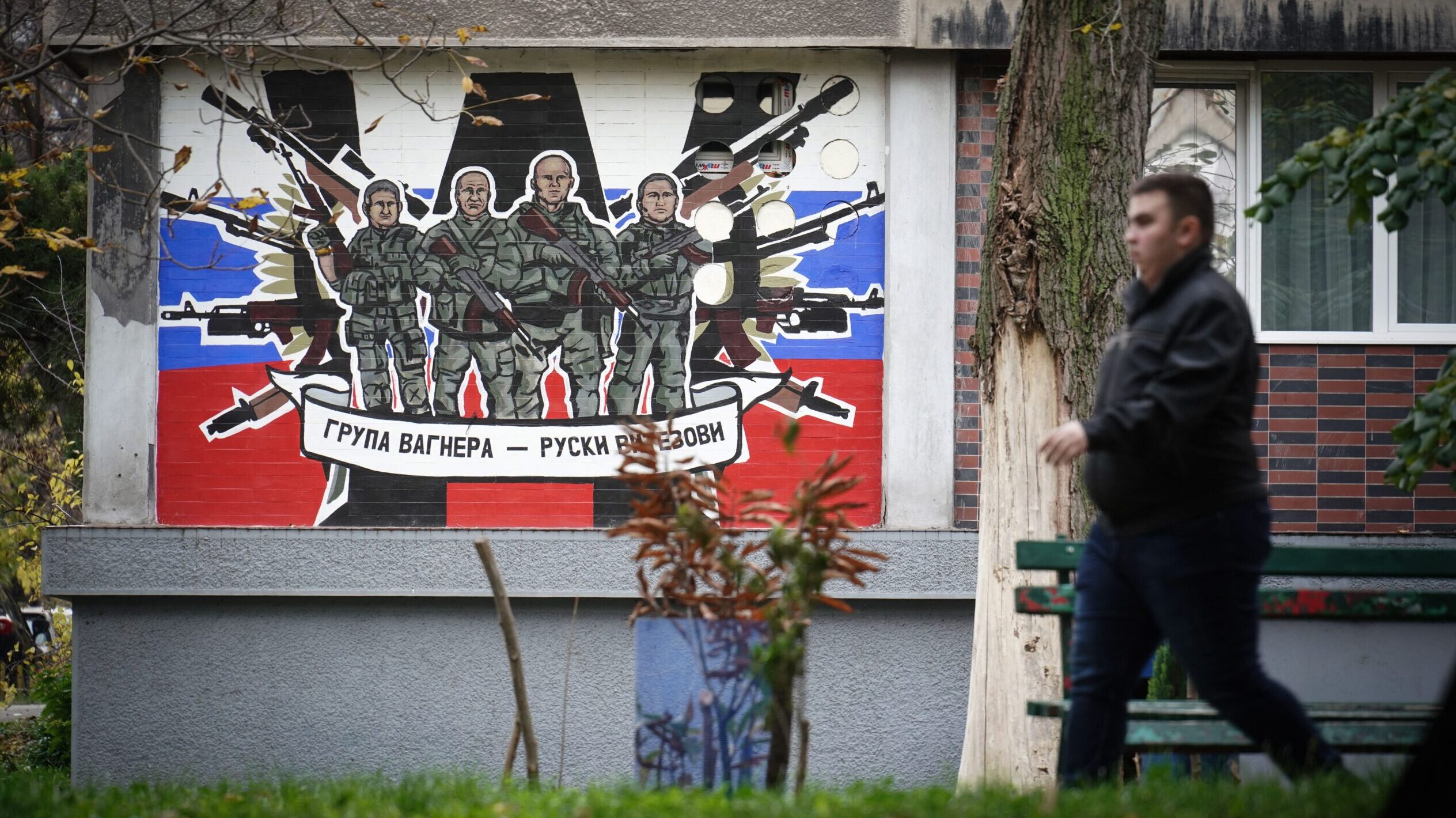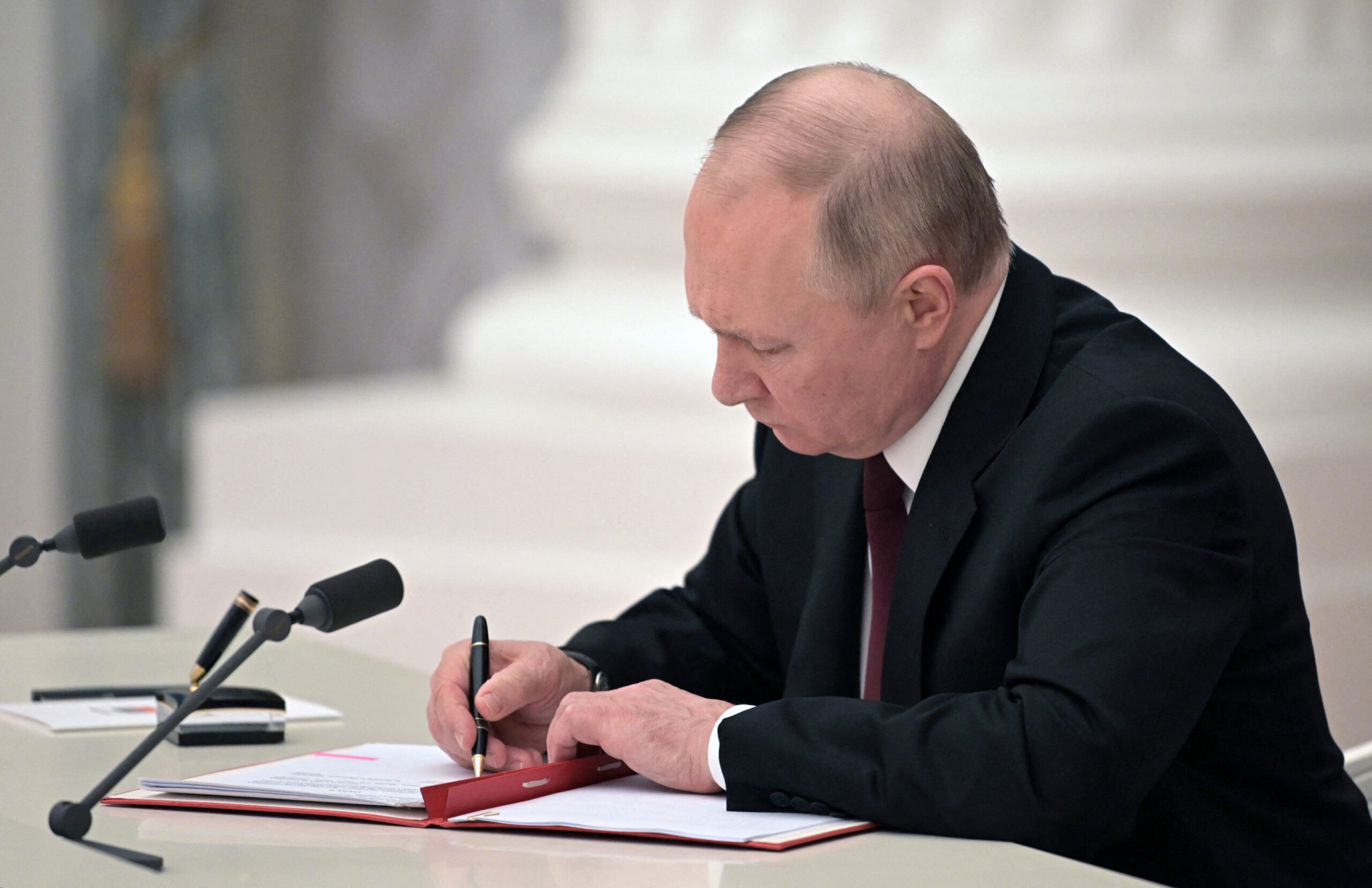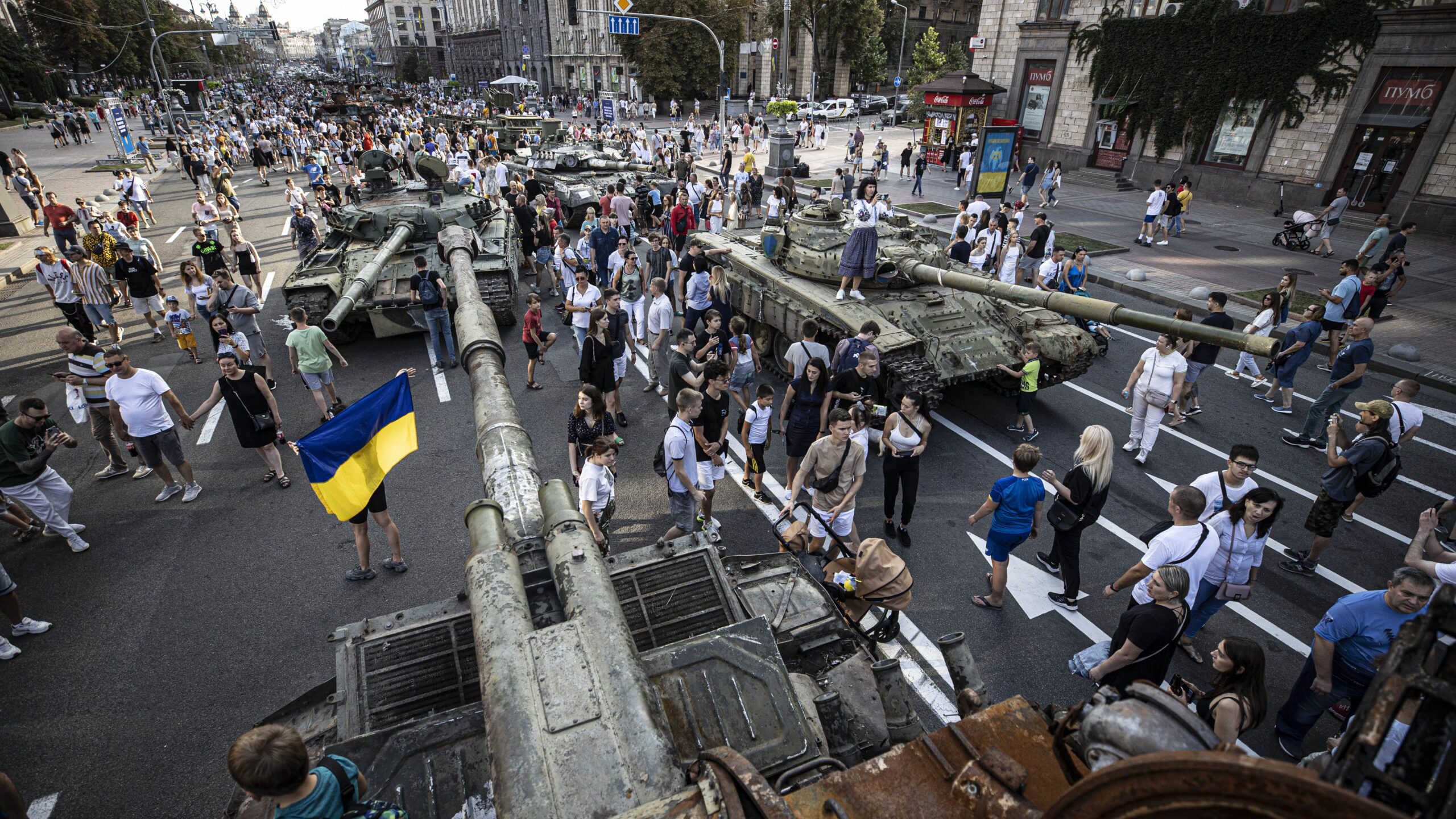
A pedestrian walks past a mural depicting Russia’s para military mercenaries ‘Wagner Group’ reading : “Wagner Group – Russian knights” on a building’s wall in Belgrade, on November 17, 2022. (OLIVER BUNIC/AFP via Getty Images)
EDITOR’S NOTE 6/25/23: Months after this report was published, Russia briefly faced what Russian President Vladimir Putin called an armed “rebellion” led by none other than Wagner chief Yevgeny Prigozhin. Read below to see how such a development is not as surprising as it might seem.
FT. LAUDERDALE, Fla. — In mid-October, the editor and owner of Moscow’s Nezavisimaya Gazeta, Konstantin Remchukov, gave an interview with the BBC on the internal dangers now building in Russia.
Remchukov, whose paper remains the only major media outlet that still manages to criticize the Russian regime, said that his chief concern was not his arrest for something his paper wrote, nor even Russia’s ultimate victory or defeat in Ukraine. Instead, he explained, his biggest worry is the growing number of heavily armed formations that are essentially parallel military establishments within Russia itself — a situation created wholly by Russian President Vladimir Putin and his attempt to find bodies to throw into the Ukrainian meat grinder.
“Different factions within the government,” he said, “will fight for the power [to rule] because evidently the competition between clans will increase … because they have a lot of weapons now. Even criminals have weapons. Chechens have weapons. Internal Ministry has weapons. The Defence Ministry has weapons. KGB — the FSB — have weapons. Everybody has weapons.”
Faced with the prospect of a humiliating defeat in the war in Ukraine, the Kremlin has turned to the traditional last refuge of Russian dictatorships — the use of brute force — in order to affect a change in the situation. While these desperate measures have so far failed to advance any prospects of a Russian victory in Ukraine, what Remchukov and others worry is that the mass arming of a population with little loyalty to a central government will ultimately lead to power grabs inside Russia — in essence, a form of civil war.
Even before the war, there was a fascinating power dynamic forming between the regular Russian military and the Wagner Group, an infamous mercenary company that has acted, effectively, its own branch of the defense forces.
Private military companies (PMC) like Wagner, which has been identified by advocates as perpetrators of human rights violations, are technically illegal in Russia. But in the last two decades the Kremlin has increasingly turned to these companies as a “off-the-books” solution for foreign policy dilemmas. They have been extremely useful in rescuing the Syrian regime of Bashar al-Assad or acting as a security force for Russian trading in gold and diamonds in order to mitigate the negative impact of western sanctions.
Wagner’s personnel were at one time drawn from Moscow’s special ops forces and earlier private military formations. Under the leadership of the company’s head, Yevgeny Prigozhin, the man sometimes known as “Putin’s chef,” the company has become an extension of the Russian state, with Prigozhin building an empire of shadowy entities that act as adjunct extensions of the Russian state.
Prigozhin has also been accused of financing and organizing the infamous Internet Research Agency. This entity, along with two other companies controlled by Prigozhin, were judged responsible for much of the more pervasive internet trolling and efforts to interfere in US elections.
RELATED: Head of US special ops in Africa likens Wagner Group to ‘terrorist organization’
But in more recent months Prigozhin, himself a former convict who spent nine years behind bars, has taken to recruiting openly for new recruits — abandoning a years-long practice of denying the company’s actual existence. By September of this year, he was recruiting new Wagner combatants from inside of Russia’s prison system. Convicts were promised that if they agreed to go to Ukraine and fight with the Wagner group for six months they would be freed from serving the remainder of their sentences. Although the convicts-turned-private-mercenaries are warned that few of them will return alive, this model of finding replacements for those Wagner mercenaries killed in action has been effective enough to maintain the company’s force levels.
Notably, Wagner has a reputation of being a truly independent actor. While it serves as Putin’s military fixer squad, it rarely coordinates with the regular military, according to a major New York Times article released this weekend. In that piece, Leonid Ivashov, a respected retired general officer in the Russian military, noted that “there was no unified planning of actions or command” between Wagner and Russia’s normal forces.
An October assessment by the Washington, DC-based Institute for the Study of War think tank notes that “Prigozhin holds a uniquely advantageous position within the Russian state structure and information space that allows him to expand his constituency in Russia more readily than the disgraced Russian higher military command … Prigozhin can freely promote himself and his forces while criticizing Kremlin officials or the Russian Armed Force without fear of pushback.”
Multiple Power Centers, All Of Them Armed
Wagner is the most well-known, but hardly the only, military power outside the regular ranks. Chechen leader Ramzan Kadyrov has his own force of Chechen units taking part in the combat, while the Russian national guard seems to operate on its own. (The New York Times piece featured an anecdote where Russian military regulars and Russian national guard forces fired upon each other.) Even within the government, Russia’s security services now use their personnel, weapons and other resources to serve their own institutional interests — which, thanks to rampant corruption, can often run counter to those of the Russian state itself.
All of these groups represent a crucial blow to a key part of any government’s legitimacy: the monopoly on the use of military force. But instead of trying to curtail non-governmental power, Russia appears poised to replicate this practice of private armies being used where the morale and fighting spirit of the regular military is lacking.
On Nov. 26 Ukraine’s defense intelligence service reported that Russian officials have appointed Armen Sarkisyan, a pro-Kremlin businessman linked to former Ukraine president Viktor Yanukovych, as the new administrator for prisons in Russian-occupied territories of Ukraine. (Yanukovych was the pro-Kremlin president of Ukraine elected in 2010, but in early 2014 was forced to flee to exile in Russia during the Maidan revolt that began the year before.)

Russian President Vladimir Putin signs documents, including a decree recognizing two Russian-backed breakaway regions in eastern Ukraine as independent, during a ceremony at the Kremlin in Moscow on February 21, 2022. (ALEXEY NIKOLSKY/Sputnik/AFP via Getty Images)
Sarkisyan, according to the Ukrainians, is planning use his position to build “a new private military company” and will use the Wagner Group’s recruitment of prisoners as the template for this new formation. The Ukrainians claim the company is being sponsored by the Russian-Armenian businessman Samvel Karapetyan. Karapetyan is the owner of Tashir Holding company, a subcontractor for well-known Russian state energy giant Gazprom.
The Ukrainian service also reports they believe there is a second agenda at work with the formation of this analogue to Wagner. Promoting this and other parallel structures promotes competition between them all — a favorite strategy employed by Putin in past years designed to keep his deputies warring with one another and off-balance.
But creating a second government-backed paramilitary group would only create yet another power center, one which will also be heavily armed.
Political scientist Andrey Piontkovsky highlighted this problem in early November. Russia will not break up peacefully into separate republics along ethnic lines, he states, but will instead be divided into armed clans that will end up fighting amongst themselves.
“The post-war situation in Russia will be the situation of 1917-18,” he said. Rather than ties to Russian oligarchs who can help flow money your way, “The strength of a politician is [now] determined by the number of armed people who obey him. This is a picture of a completely new Russia.
“The power of Prigozhin and the strength of Kadyrov is that they have 30,000 armed soldiers who obey only them,” Piontkovsky said. “You can see that on the front, there are a lot of situations and clashes between these structures and the Russian armed forces. And put yourself in the place of the generals, whom some field commanders call every day to deprive them of their ranks, shoot them, send them to the front as privates,” he added, a reference to statements made by Prigozhin.
A Failing State?
This would all be less a growing concern if Russia was functioning as a full-fledged, successful state. But analysts agree that simply isn’t the case.
Last month the political scientist Ekaterina Schulmann told The Economist that “the Russian Federation as we know it is self-liquidating and passing into a failed-state phase.” Its administration, she continued, is unable to carry out its basic functions.
This includes the most basic mandate of any government, which is the protection of its citizenry. But Putin’s regime now presents the greatest threat to that citizenry by threatening to forcibly conscript them in the hundreds of thousands and send them into battle with almost no proper equipment and even less training.
And for those lucky enough to make it back over Russia’s border, the Kremlin’s decision to have each region of Russia create battalions of soldiers to send to Ukraine could have further blowback. According to Remchukov, the Nezavisimaya Gazeta editor, “at least eight regions” have created such units. “So, if you are leader of the region and you have two or three battalions [under your command], you are quite a king on this land.”

Ukrainians arrive at Khreschatyk Street to see the seized military equipment and weapons including tank and motorized artillery systems belonging to the Russian army displayed by Ukraine ahead of the country’s 31st anniversary of Independence Day in Kyiv, Ukraine on August 21, 2022. (Photo by Metin Aktas/Anadolu Agency via Getty Images)
Especially with how the Russian conscription process has drawn heavily from poorer regions further from Moscow, the idea that these armed forces could return to their distant homes with military experience and a bitterness towards the Kremlin should raise eyebrows.
Those conscripts and others that survive after the defeat of Russia, will “return to the capital with their machine guns, as the peasant mobilized with rifles returned in 1917,” warns Piontkovsky. He sees the government and the armed forces disintegrating into groups that are little more than armed camps at war with one another, a political environment that he characterizes as “military feudalism.”
Already, the war has spurred calls from different ethnic regions in Russia for independence. Rather than showing the strength of Moscow’s imperial reach, the empty declaration that Donetsk, Lugansk, Kherson and Zaporizhia are now under Putin’s rule — which came roughly six weeks before Russian forces were forced to flee Kherson — has only empowered the regions of Russia seeking to break away. Russian currently controls only 17 percent of Ukrainian territory, which is the least amount of area that its forces have occupied since April.
One of Putin’s options may be to try and regain the advantage in Ukraine by exacerbating his long-term domestic problems. Rumors in Moscow are that another mobilization could be announced as early as the second half of January, and that this time it would not be a “partial” mobilization but a full-on conscription drive. (Of note, that would line up with how leaders Ukraine are sounding the alarm that they expect another major push towards Kyiv to come in the coming months.)
As it is, a significant number of fighting-age men fled the country in the wake of the first mobilization. Ben Hodges, a retired head of US Army forces in Europe, said in October that he sees the idea of further mobilization as a sign of weakness from Putin.
“Obviously as well for the people it’s made clear that Putin is losing control inside Russia,” he said. “Half a million Russian men of military age left Russia to avoid mobilization. That tells you the Russian people have no stomach for this fight, they don’t want to be there.”
The question now is what those who do end up going back home from the fight will do once they return.
‘AI-BOM’ bombs: Army backs off, will demand less detailed data from AI vendors
Instead of demanding an exhaustive “AI Bill of Materials.” the Army will only ask contractors for a “baseball card” of key stats on their AI — while building up its in-house capacity to check for bad code or “poisoned” data.



























